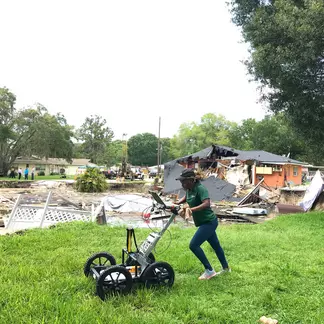Unit 1: What Is Ground-Penetrating Radar?
Summary
This unit introduces the concepts behind ground-penetrating radar (GPR) through a comparison to medical imaging, building on what students may already know or be familiar with. The concepts are then extended to show what types of features underground can be imaged with GPR and how GPR is commonly used. This provides an overview of how GPR works and how it can be used in urban environments. We highlight two applications in particular: utilities and graves.
Learning Goals

- Describe how a GPR system operates.
- Describe how GPR images underground features that are made of a material different than the surrounding ground.
- Identify similarities and differences between GPR and medical imaging methods.
- Describe the strengths and weaknesses of medical imaging with the understanding that GPR has strengths and weaknesses also.
- Explain why a tool like GPR may be a preferred method instead of excavation.
- Know/identify the type of buried objects that GPR is useful for imaging in an urban environment.
Context for Use
This unit is intended for undergraduate students with no previous exposure to geophysics. There is no math or science prerequisite.
The instructor can expect to spend about one class period with this material depending on class length and size. Student materials may include background reading provided as links in the presentation. The instructor also has the option to use the examples of GPR in engineering and forensic applications for class discussions. Assessment activities may be done in groups or as individuals.
Description and Teaching Materials
The teaching material includes a PowerPoint presentation with external links. The links, which are provided as hyperlinks and URLs, are to YouTube videos and articles that provide additional instructional content. The videos explain the physics of medical imaging techniques and GPR. The blog and news articles offer case examples of GPR in engineering and forensic applications.
- What is GPR slides (PowerPoint 2007 (.pptx) 9.3MB Sep6 24)
Teaching Notes and Tips
- Students may struggle to understand that a ray description of waves just shows the travel path of one part of the outgoing spherical wavefront.
Assessment
Student assessment material includes fill-in-the-blank questions to confirm that students read through the PowerPoint and watch the videos, and open-ended questions that can be used in a think-pair-share format. The assessment is designed to be completed as students follow along with the slide presentation or refer to the slides outside of class. This worksheet may also serve as a source of quiz or test questions if desired. Think-pair-share questions are best implemented during class time. These may also serve as short essay questions to be answered individually.
- What is GPR student assessment questions (Microsoft Word 2007 (.docx) 98kB Sep15 24)
Solutions for instructors
References and Resources
Geosci.xyz is an open-source educational resource for the geosciences. The site provides a comprehensive explanation of GPR theory that the instructor may refer to as needed to expand on this unit.



